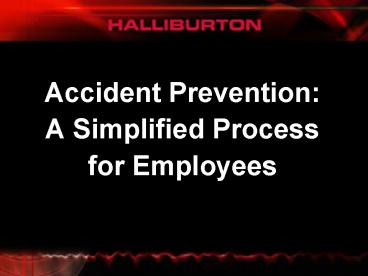Accident Prevention: - PowerPoint PPT Presentation
1 / 27
Title:
Accident Prevention:
Description:
Accident Prevention: A Simplified Process. for Employees. Instructors. Halliburton. Bryan Wollam HSE & Operational Excellence Manager. Work Phone: 817-761-2272 ... – PowerPoint PPT presentation
Number of Views:19396
Avg rating:5.0/5.0
Title: Accident Prevention:
1
- Accident Prevention
- A Simplified Process
- for Employees
2
Instructors
Halliburton Bryan Wollam
HSE Operational Excellence Manager Work
Phone 817-761-2272 bryan.wollam_at_halliburton.com
Halliburton Keith Utter
HSE Supervisor Work Phone
817-761-2012 keith.utter_at_halliburton.com
3
- Employee
- Accident Terminology
4
Safety
Accident Terminology
- The control of
- accidental loss
- Websters Definition The Act of being Safe
5
Accident
An Undesired Exchange of Energy (Contact Made)
- which causes loss to
- People
- Property
- Process
- Environment
Websters Definition An unexpected, undesired
event.
6
Incident
- An Undesired Exchange of Energy
- (Contact Made)
- which under slightly different circumstances
could have caused loss to people, property,
process or the environment - No loss to people, property, process or the
environment.
7
Near Miss
- An Undesired Event No Energy Exchanged
- (No Contact Made)
- which under slightly different circumstances
could have caused loss to people, property,
process or the environment
8
- Energy Exchange with
- a Consequence
- Loss to people, property or process
- Energy Exchange without
- a Consequence
- Contact Made
- No Energy Exchanged
- Close Call
- Accident
- Incident
- Near Miss
9
Injury Pyramid
- 1
- Serious or
- Disabling Injury
- 10
- Minor Injuries
- 30
- Property Damage
- 600
- Incidents
- 1000
- Near Misses
- ???
- Unsafe Acts / Unsafe Conditions
10
Accident Prevention
- 97 of all Industrial Accidents involve 3
factors - Unsafe Practice or Act
- Unsafe Condition
- An Event (Energy Exchange)
Remove one of them and you prevent the accident
from occurring
11
Near Miss/Accident/Incident Model
- Unsafe
- Practice
- or Act
- and/or
- Unsafe
- Condition
12
Near Miss/Accident/Incident Model
- Unsafe E
- Practice v
- or Act e
- n
- and/or t
- Unsafe Energy
- Condition
13
Near Miss/Accident/Incident Model
- Unsafe E
- Practice v
- or Act e
- n
- and/or t
- Unsafe Energy
- Condition
- Accident
- Luck
- Factor Incident
- Near
- Miss
14
Loss Control
- Simple as 1,2,3
- Recognize the potential hazard or risk.
- Stop the event that is taking place.
- Correct the hazard or risk.
15
Prevent Process Related Accidents
- A MANAGEMENT MODEL
- OSHA Management of Change, not just for PSM
Facilities.
16
Management of Change A Five Step Process
Process Safety Information PSI
Process Hazard Analysis PHA Quality/HSE Aspect
Impacts
VALIDATION Follow-Up Establish Metrics for
Sustainability
Management of Change Evaluation MOC
Pre-Start Up Q HSE Review PSR
If the change is not effective
MOC is a Continual Improvement Process
17
Uncover Potential Accidents Before They Happen
- Think Ahead
- Stay Alert
- Ask Questions
- Take Action
18
What is a Hazard?
- A hazard is any source (thing, substance,
material, source of energy, stressor, condition,
process and/or practice) that has the potential
to create damage or harm (consequence) on
something or someone under certain conditions
(OSHA).
19
Hazard Recognition
- Hazard recognition is being able to identify a
source that has the potential to cause injury,
harm, damage or loss. - During a task or observation ask yourself
- What conditions might contribute to injury,
- harm, loss or damage?
- What is involved in this task that could hurt me
- or my co-workers?
- How can injury, harm, damage or loss be
- prevented?
20
Risk
Risk is the chance or likelihood (probability)
that a person will be harmed or experience ill
health if exposed to a hazard. Risk also applies
to property damage or equipment loss Dont
confuse likelihood of exposure to likelihood of
an injury. Driving exposure is high but injury
likelihood is low.
21
Risk
- Risk is a Combination of
- How likely the hazard will cause harm or damage
(probability). - How severe the harm or damage could be.
Risk Probability X Severity
22
Personal Factors
Risk
- How might age affect risk taking?
- In what ways might experience eliminate or
enhance risk taking? - How might physical ability contribute to risk
taking? - How might knowledge and skills facilitate the
correction or acceptance of risk?
23
Organizational Factors that Might Influence Risk
Taking
Risk
- Safety Systems
- Are processes and/or equipment lacking,
discouraging people to do a job safely? Do we
talk safety with little evidence of walking the
talk? - Leadership Behaviors
- Are at-risk, time saving actions accepted? What
are the prevailing attitudes? - Peer Behaviors
- Do our co-workers discourage at-risk behaviors?
What is the culture?
24
Before Performing a Task Ask Yourself
As a Reminder
- What hazards are involved in the task?
- Can I minimize or prevent the risk of injury,
harm, damage or loss? - Do I need help to reduce the hazard?
- Is there a better time to do the task?
- What specific PPE and tools are required?
- Is there a JSA, JHA, PHA, or SOP that I need to
review?
25
Consequences of Accidents
- Direct Consequences
- Personal injury
- Property loss
- Process loss
- Indirect Consequences
- Lost income
- Medical expenses
- Time to retrain another person
- Decreased employee moral
26
When we recognize hazardsWe prevent accidents
and injuries
27
Accident Prevention
- Questions?































